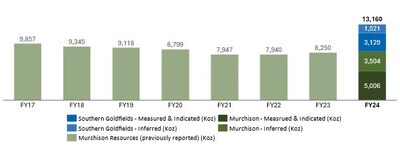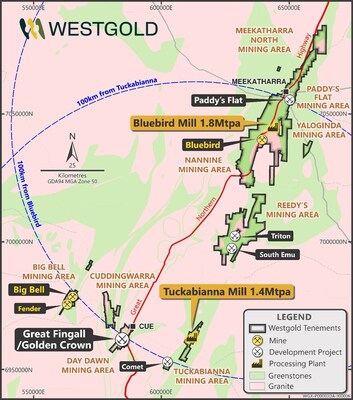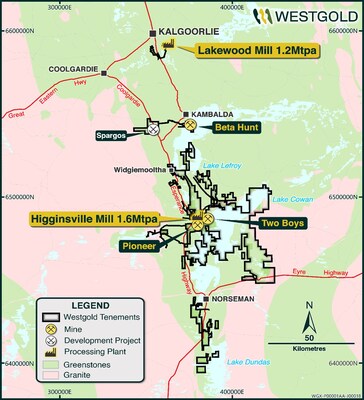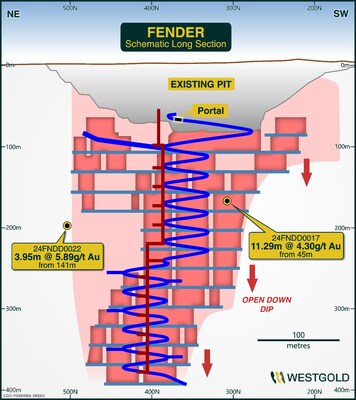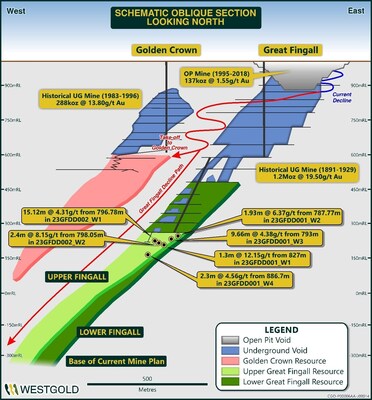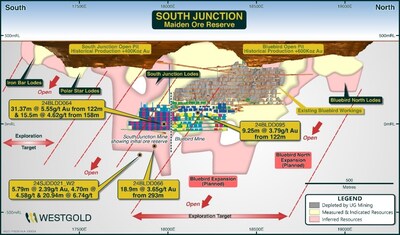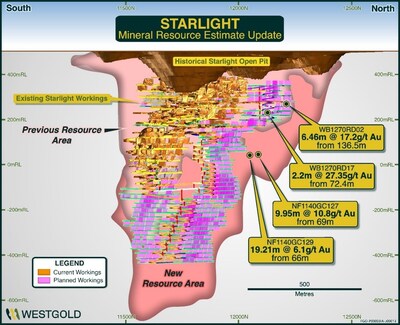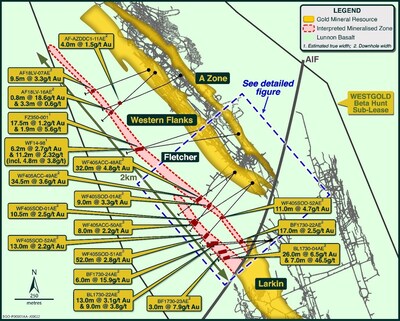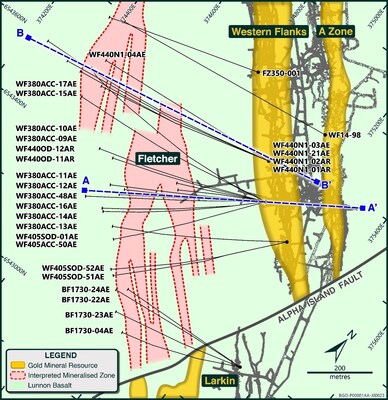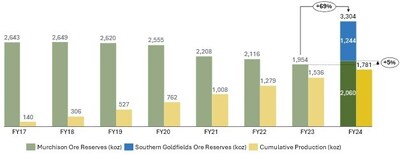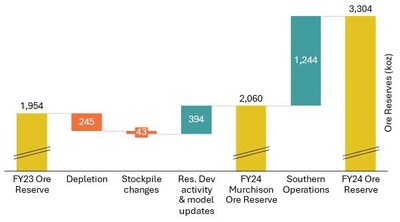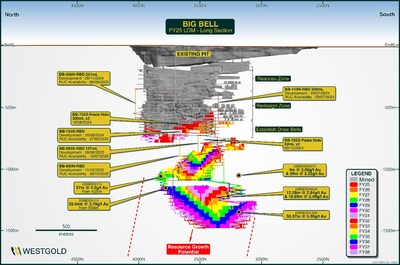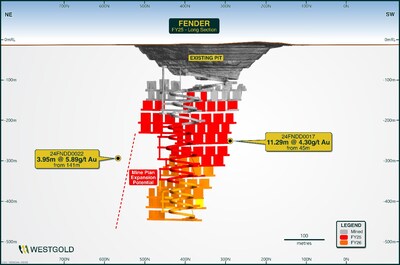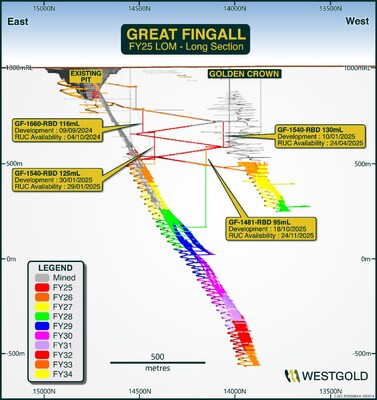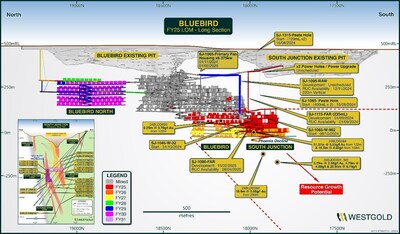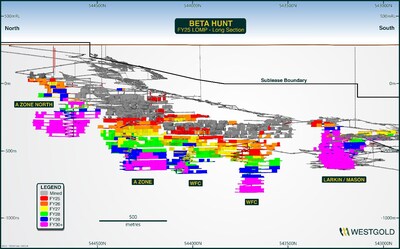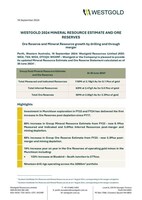WESTGOLD 2024 MINERAL RESOURCE ESTIMATE AND ORE RESERVES
Ore Reserve and Mineral Resource growth by drilling and through merger
|
Group Gold Mineral Resource Estimate |
At |
|
Total Measured and Indicated Resources |
|
|
Total Inferred Resources |
63Mt at 2.47g/t Au for 5.0 Moz of gold |
|
Total Ore Reserves |
50Mt at 2.05g/t Au for 3.3Moz of gold |
Highlights
|
|
Investment in Murchison exploration in FY23 and FY24 has delivered the |
|
|
60% increase in Group Mineral Resource Estimate from FY23 - now 8.1Moz |
|
|
69% increase in Group Ore Reserve Estimate from FY23 - now 3.3Moz post- |
|
|
10% increase year on year in the Ore Reserves of operating gold mines in the
|
|
|
Nineteen drill rigs operating across the 3200km2 portfolio |
|
____________________________________ |
|
|
Westgold Managing Director
"Westgold is growing our business both organically and inorganically.
Drilling investment over FY23 and FY24 has delivered the first increase in Murchison Ore Reserves since 2017. On an inorganic basis the integration of the Southern Goldfields assets has lifted our Measured and Indicated Resource base to 8.1Moz, Inferred Resource base to 5.0Moz and Ore Reserves to 3.3Moz.
Resource conversion across the portfolio is our focus and opportunities are abundant. The Starlight mine continues to grow in stature, the Bluebird-South Junction complex continues to grow in scale, and through drilling, the emerging
Westgold today has 19 drill rigs operating across our portfolio and this investment will continue to unlock value from our 3,200km2 of tenure across two of
2024 Mineral Resource Estimate
As of
This represents 60% growth in the Company's gold Mineral Resource base year on year underpinned by both a continued significant campaign of exploration and resource definition drilling over FY24 (investing
Figure 1 – Westgold has achieved Mineral Resource growth in FY23 and FY24.4
The Murchison Operations incorporate the Bluebird, Tuckabianna and Fortnum processing hubs while the Southern Goldfields Operations incorporate the Lakewood and Higginsville processing hubs.
Tables 1, 2 and 3 below depict the FY24 Mineral Resource Estimates for the Murchison and Southern Goldfields Operations.
|
___________________________________ |
|
|
Table 1 – Gold Mineral Resource Estimates at
|
Murchison Gold Operations |
||||||||||||
|
Mineral Resource Statement - Rounded for Reporting |
||||||||||||
|
|
||||||||||||
|
|
Measured |
Indicated |
Measured and Indicated |
Inferred |
||||||||
|
Operating Mine |
Tonnes ('000s) |
Grade |
Ounces Au ('000s) |
Tonnes ('000s) |
Grade |
Ounces Au ('000s) |
Tonnes ('000s) |
Grade |
Ounces Au ('000s) |
Tonnes ('000s) |
Grade |
Ounces Au ('000s) |
|
|
|
|
|
|
|
|
|
|
|
|
|
|
|
Big Bell UG |
4,022 |
3.07 |
397 |
7,965 |
3.33 |
853 |
11,988 |
3.24 |
1,250 |
5,927 |
3.11 |
593 |
|
Fender UG |
95 |
3.22 |
10 |
201 |
3.05 |
20 |
297 |
3.10 |
30 |
345 |
3.33 |
37 |
|
Great Fingall UG |
0 |
0.00 |
0 |
1,616 |
5.25 |
273 |
1,616 |
5.25 |
273 |
883 |
3.51 |
100 |
|
Golden Crown UG |
0 |
0.00 |
0 |
333 |
6.18 |
66 |
333 |
6.18 |
66 |
944 |
5.14 |
156 |
|
Bluebird Group UG |
304 |
4.09 |
40 |
4,368 |
3.03 |
425 |
4,672 |
3.10 |
465 |
6,032 |
2.55 |
495 |
|
Starlight UG |
881 |
4.01 |
114 |
1,973 |
3.44 |
218 |
2,854 |
3.62 |
332 |
2,588 |
3.13 |
260 |
|
|
|
|
|
|
|
|
|
|
|
|
|
|
|
Total |
5,303 |
3.29 |
561 |
16,457 |
3.51 |
1,855 |
21,760 |
3.45 |
2,415 |
16,719 |
3.05 |
1,641 |
|
Southern Goldfields Gold Operations |
||||||||||||
|
Mineral Resource Statement - Rounded for Reporting |
||||||||||||
|
|
||||||||||||
|
|
Measured |
Indicated |
Measured and Indicated |
Inferred |
||||||||
|
Operating Mine |
Tonnes ('000s) |
Grade |
Ounces Au ('000s) |
Tonnes ('000s) |
Grade |
Ounces Au ('000s) |
Tonnes ('000s) |
Grade |
Ounces Au ('000s) |
Tonnes ('000s) |
Grade |
Ounces Au ('000s) |
|
|
|
|
|
|
|
|
|
|
|
|
|
|
|
Two Boys |
24 |
1.55 |
1 |
1,141 |
2.32 |
85 |
1,165 |
2.30 |
86 |
184 |
2.78 |
16 |
|
Pioneer |
0 |
0.00 |
0 |
519 |
2.11 |
35 |
519 |
2.11 |
35 |
345 |
1.50 |
17 |
|
Beta Hunt |
1,142 |
2.79 |
102 |
16,581 |
2.74 |
1,458 |
17,723 |
2.74 |
1,561 |
12,860 |
2.63 |
1,086 |
|
|
|
|
|
|
|
|
|
|
|
|
|
|
|
Total |
1,166 |
2.76 |
104 |
18,241 |
2.69 |
1,579 |
19,407 |
2.70 |
1,682 |
13,388 |
2.60 |
1,119 |
Table 2 – Gold Mineral Resource Estimates at
|
Murchison Gold Operations |
||||||||||||
|
Mineral Resource Statement - Rounded for Reporting |
||||||||||||
|
|
||||||||||||
|
|
Measured |
Indicated |
Measured and Indicated |
Inferred |
||||||||
|
Project |
Tonnes ('000s) |
Grade |
Ounces Au ('000s) |
Tonnes ('000s) |
Grade |
Ounces Au ('000s) |
Tonnes ('000s) |
Grade |
Ounces Au ('000s) |
Tonnes ('000s) |
Grade |
Ounces Au ('000s) |
|
|
|
|
|
|
|
|
|
|
|
|
|
|
|
|
60 |
2.81 |
5 |
802 |
2.64 |
68 |
861 |
2.65 |
73 |
1,848 |
2.94 |
175 |
|
Cuddingwarra |
85 |
1.66 |
5 |
1,600 |
1.63 |
84 |
1,685 |
1.63 |
88 |
597 |
1.50 |
29 |
|
|
58 |
1.73 |
3 |
1,068 |
2.04 |
70 |
1,126 |
2.02 |
73 |
1,043 |
1.78 |
60 |
|
Tuckabianna |
267 |
3.54 |
30 |
3,448 |
2.78 |
308 |
3,715 |
2.84 |
339 |
2,899 |
2.63 |
245 |
|
Tuckabianna Stockpiles |
81 |
2.09 |
5 |
3,627 |
0.70 |
81 |
3,709 |
0.73 |
87 |
0 |
0.00 |
0 |
|
Meekatharra North |
0 |
0.00 |
0 |
97 |
1.98 |
6 |
97 |
1.98 |
6 |
75 |
2.11 |
5 |
|
Nannine |
68 |
2.55 |
6 |
859 |
2.06 |
57 |
927 |
2.09 |
62 |
340 |
2.26 |
25 |
|
Paddy's Flat |
376 |
3.67 |
44 |
10,641 |
1.65 |
564 |
11,017 |
1.72 |
608 |
2,574 |
1.93 |
160 |
|
Reedy's |
430 |
3.77 |
52 |
3,225 |
2.58 |
267 |
3,656 |
2.72 |
319 |
9,191 |
2.54 |
750 |
|
|
53 |
2.59 |
4 |
4,128 |
1.47 |
195 |
4,181 |
1.49 |
200 |
5,879 |
1.40 |
265 |
|
Bluebird Stockpiles |
350 |
1.34 |
15 |
0 |
0.00 |
0 |
350 |
1.34 |
15 |
0 |
0.00 |
0 |
|
|
332 |
2.67 |
28 |
2,951 |
2.08 |
197 |
3,282 |
2.14 |
226 |
618 |
1.88 |
37 |
|
Horseshoe |
0 |
0.00 |
0 |
1,266 |
2.09 |
85 |
1,266 |
2.09 |
85 |
183 |
1.43 |
8 |
|
Peak Hill |
0 |
0.00 |
0 |
7,547 |
1.55 |
376 |
7,547 |
1.55 |
376 |
1,838 |
1.78 |
105 |
|
FGO Stockpiles |
723 |
0.95 |
22 |
481 |
0.69 |
11 |
1,204 |
0.85 |
33 |
16 |
0.54 |
0 |
|
|
|
|
|
|
|
|
|
|
|
|
|
|
|
Total |
2,884 |
2.39 |
221 |
41,741 |
1.77 |
2,370 |
44,625 |
1.81 |
2,591 |
27,100 |
2.14 |
1,864 |
|
Southern Goldfields Gold Operations |
||||||||||||
|
Mineral Resource Statement - Rounded for Reporting |
||||||||||||
|
|
||||||||||||
|
|
Measured |
Indicated |
Measured and Indicated |
Inferred |
||||||||
|
Project |
Tonnes ('000s) |
Grade |
Ounces Au ('000s) |
Tonnes ('000s) |
Grade |
Ounces Au ('000s) |
Tonnes ('000s) |
Grade |
Ounces Au ('000s) |
Tonnes ('000s) |
Grade |
Ounces Au ('000s) |
|
|
|
|
|
|
|
|
|
|
|
|
|
|
|
HGO Central |
931 |
2.94 |
88 |
2,442 |
2.74 |
215 |
3,373 |
2.80 |
303 |
1,519 |
2.91 |
142 |
|
HGO Greater |
466 |
3.00 |
45 |
2,799 |
2.79 |
251 |
3,265 |
2.82 |
296 |
1,999 |
2.39 |
154 |
|
Mt Henry |
11,042 |
1.19 |
424 |
10,172 |
1.16 |
378 |
21,214 |
1.18 |
802 |
2,565 |
1.28 |
106 |
|
HGO Stockpiles |
373 |
0.40 |
5 |
1,568 |
0.76 |
38 |
1,940 |
0.69 |
43 |
0 |
0.00 |
0 |
|
BHO Stockpiles |
47 |
2.09 |
3 |
0 |
0.00 |
0 |
47 |
2.09 |
3 |
0 |
0.00 |
0 |
|
|
|
|
|
|
|
|
|
|
|
|
|
|
|
Total |
12,859 |
1.37 |
565 |
16,981 |
1.62 |
882 |
29,840 |
1.51 |
1,447 |
6,083 |
2.05 |
402 |
Table 3 – Nickel Mineral Resource Estimates at
|
Beta Hunt Nickel Operations |
||||||||||||
|
Mineral Resource Statement - Rounded for Reporting |
||||||||||||
|
|
||||||||||||
|
|
Measured |
Indicated |
Measured and Indicated |
Inferred |
||||||||
|
Project |
Tonnes |
Ni (%) |
NiT ('000s) |
Tonnes |
Ni (%) |
NiT ('000s) |
Tonnes |
Ni (%) |
NiT ('000s) |
Tonnes |
Ni (%) |
NiT ('000s) |
|
|
|
|
|
|
|
|
|
|
|
|
|
|
|
Beta Hunt |
0 |
0.0 % |
0 |
749 |
2.8 % |
21 |
749 |
2.8 % |
21 |
499 |
2.7 % |
13 |
|
|
|
|
|
|
|
|
|
|
|
|
|
|
|
Total |
0 |
0.0 % |
0 |
749 |
2.8 % |
21 |
749 |
2.8 % |
21 |
499 |
2.7 % |
13 |
See Figure 2, Figure 3 and Figure 4 for location details. Additional detailed information relating to generation of the Mineral Resource Estimates is attached in Appendix B & C Table 1 – JORC 2012 Reporting Criteria.
Figure 2 - Murchison Operations Project Areas (Bluebird & Tuckabianna).
Figure 3 - Murchison Operations Project Areas (Fortnum)
Figure 4 – Southern Goldfields Operations Project Area.
Geology
The Meekatharra Gold operation is located in the
The Paddy's Flat area is located on the western limb of a regional fold, the Polelle Syncline, within a sequence of mafic to ultramafic volcanics with minor interflow sediments and banded iron-formation. The sequence has also been intruded by felsic porphyry dykes prior to mineralisation. Mineralisation is located along four sub-parallel trends at Paddy's Flat and can be comprised of sulphide replacement BIF hosted gold, quartz vein hosted shear-related gold and quartz-carbonate-sulphide stockwork vein and alteration related gold.
The Yaloginda area which hosts Bluebird –
The sequence was intruded by a variety of felsic porphyry and intermediate sills and dykes.
The Reedy's mining district is located approximately 50 km to the south-east to Meekatharra and to the south of
The Cue Gold Operations are located in the
Mineralisation at Big Bell is hosted in the shear zone (Mine Sequence) and is associated with the post-peak metamorphic retrograde assemblages. Stibnite, native antimony and trace arsenopyrite are disseminated through the K-feldspar-rich lode schist. These are intergrown with pyrite and pyrrhotite and chalcopyrite. Mineralisation outside the typical Big Bell host rocks (KPSH), for example 1,600N and Shocker, also display a very strong W-As-Sb geochemical halo.
Numerous gold deposits occur within the
The Great Fingall Dolerite hosts the majority gold mineralisation within the portion of the greenstone belt proximal to Cue (The Day Dawn Project Area). Unit AGF3 is the most brittle of all the five units and this characteristic is responsible for its role as the most favourable lithological host to gold mineralisation in the Greenstone Belt.
The Fortnum deposits are Paleoproterozoic shear-hosted gold deposits within the Fortnum Wedge, a localised thrust duplex of Narracoota Formation within the overlying Ravelstone Formation. Both stratigraphic formations comprise part of the
The Horseshoe Cassidy deposits are hosted within the Ravelstone Formation (siltstone and argillite) and Narracoota Formation (highly altered, moderate to strongly deformed mafic to ultramafic rocks). The main zone of mineralisation is developed within a horizon of highly altered magnesian basalt. Gold mineralisation is associated with strong vein stock works that are confined to the altered mafic. Alteration consists of two types: stockwork proximal silica-carbonate-fuchsite-haematite-pyrite and distal silica-haematite-carbonate+/- chlorite.
The Peak Hill district represents remnants of a Proterozoic fold belt comprising highly deformed trough and shelf sediments and mafic / ultramafic volcanics, which are generally moderately metamorphosed (except for the Peak Hill Metamorphic Suite).
The Beta Hunt Gold Operations are situated within the central portion of the Norseman-Wiluna greenstone belt in a sequence of mafic / ultramafic and felsic rocks on the southwest flank of the Kambalda Dome. Gold mineralisation occurs mainly in subvertical shear zones in the Lunnon Basalt and is characterised by shear and extensional quartz veining within a halo of biotite/pyrite alteration. Within these shear zones, coarse gold sometimes occurs where the shear zones intersect iron-rich sulphidic metasediments in the Lunnon Basalt or nickel sulphides at the base of the Kambalda Komatiite (ultramafics). The mineralised shears are represented by A-Zone, Western Flanks, Larkin and Mason zones.
The Higginsville Gold Operation is located in the Eastern Goldfields Superterrane of the Archean Yilgarn Craton. The bulk of the Higginsville tenement package is located almost entirely within the well-mineralised Kalgoorlie Terrane, between the gold mining centres of Norseman and
Majority of mineralisation along the Trident Line of Lode are hosted within the Poseidon gabbro and high-MgO dyke complexes in the south. The Poseidon Gabbro is a thick, weakly-differentiated gabbroic sill, which strikes north-south and dips 60° to the east, is over 500 m thick and 2.5 km long. The mineralisation is hosted within or marginal to quartz veining and is structurally and lithologically controlled.
The Chalice Deposit is located within a north-south trending, 2 km to 3 km wide greenstone terrane, flanked on the west calc-alkaline granitic rocks of the Boorabin Batholith and to the east by the Pioneer Dome Batholith. The dominant unit that hosts gold mineralisation is a fine grained, weak to strongly foliated amphibole-plagioclase amphibolite, with a typically lepidoblastic (mineralogically aligned and banded) texture. It is west-dipping and generally steep, approximately 60° to 75°.
The
Mineralised zones within the Southern Paleo Channels network comprise both placer gold, normally near the base of the channel-fill sequences, and chemically-precipitated secondary gold within the channel-fill materials and underlying saprolite. These gold concentrations commonly overlie, or are adjacent to, primary mineralised zones within Archaean bedrock.
The Polar Bear project is situated within the Archaean Norseman-Wiluna Belt which locally includes basalts, komatiites, metasediments, and felsic volcaniclastics. The primary gold mineralisation is related to hydrothermal activity during multiple deformation events. Indications are that gold mineralisation is focused on or near to the stratigraphic boundary between the
The
Background to the Mineral Resource Estimate
Geological interpretation of individual deposits is carried out using a systematic approach to ensure that the resultant estimated Mineral Resource Estimate was both sufficiently constrained, and representative of the expected sub-surface conditions. In all aspects of Mineral Resource Estimation, the factual and interpreted geology was used to guide the development of the interpretation. Geological matrixes were established to assist with interpretation and construction of the estimation domains.
A significant portion of the data used in Mineral Resource Estimations has been gathered from diamond core. Multiple sizes have been used. This core is geologically logged and subsequently halved for sampling. Grade control holes may be whole-cored to streamline the core handling process if required. Face sampling data is also utilised, where each development face / round is horizontally chip sampled. The sampling intervals are domained by geological constraints (e.g. rock type, veining and alteration / sulphidation etc.).
All geology input is logged and validated by the relevant area geologists, incorporated into this is assessment of sample recovery. No defined relationship exists between sample recovery and grade. Nor has sample bias due to preferential loss or gain of fine or coarse material been noted.
Faces are nominally chipped horizontally across the face from left to right, sub-set via geological features as appropriate. Diamond drilling is half-core niche sampled, sub-set via geological features as appropriate.
Samples undergo fine pulverisation of the entire sample by an LM5 type mill to achieve a 75µ product prior to splitting. QA/QC is currently ensured during the sub-sampling stages process via the use of the systems of an independent NATA / ISO accredited laboratory contractor. The sample size is considered appropriate for the grain size of the material being sampled. The un-sampled half of diamond core is retained for check sampling if required.
Sampling is analysed for gold by fire assay as outlined below;
- A 40g – 50g sample undergoes fire assay lead collection followed by flame atomic adsorption spectrometry.
- Quality control is ensured via the use of standards, blanks and duplicates. The laboratory includes a minimum of 1 project standard with every 22 samples analysed. No significant QA/QC issues have arisen in recent drilling results.
Photon Assay was introduced in 2023 for Beta Hunt gold grade control samples. PhotonAssay™ technology (Chrysos Corporation Limited) is a rapid, non-destructive analysis of gold and other elements in mineral samples. It is based on the principle of gamma activation, which uses high energy x-rays to excite changes to the nuclear structure of selected elements. The decay is then measured to give a gold analysis. Each sample is run through two cycles with a radiation time of 15s. This methodology is insensitive to material type and thus does not require fluxing chemicals as in the fire assay methodology.
Nickel analyses have been completed by 4 acid digest and final analysis using ICP-OES.
After validating the drillhole data to be used in the estimation, interpretation of the orebody is undertaken to create the outline strings which form the basis of the three-dimensional orebody wireframe. Wireframing is then carried out using a combination of automated stitching algorithms and manual triangulation to create an accurate three-dimensional representation of the sub-surface mineralised body.
Drillhole intersections within the mineralised body are defined, these intersections are then used to flag the appropriate sections of the drillhole database tables for compositing purposes. Drillholes are subsequently composited to allow for grade estimation. In all aspects of resource estimation, the factual and interpreted geology was used to guide the development of the interpretation.
Once the sample data has been composited, a statistical analysis is undertaken to assist with determining estimation search parameters, top-cuts etc. Analysis of individual domains is undertaken to assist with determining appropriate search parameters. Which are then incorporated with observed geological and geometrical features to determine the most appropriate search parameters.
An empty block model is then created for the area of interest. This model contains attributes set at background values for the various elements of interest as well as density, and various estimation parameters that are subsequently used to assist in resource categorisation. The block sizes used in the model will vary depending on orebody geometry, minimum mining units, estimation parameters and levels of informing data available.
Grade estimation is then undertaken. Ordinary kriging estimation method is considered as standard. Estimation results are validated against primary input data, previous estimates and mining output.
The Mineral Resource is then depleted for mining voids and subsequently classified in line with JORC guidelines utilising a combination of various estimation derived parameters and geological / mining knowledge.
Data spacing is variable dependent upon the individual lode under consideration.
This approach considers all relevant factors and reflects the Competent Person's view of the deposit.
The cut off grades used for the reporting of the Mineral Resources Estimates is selected based upon the style of mineralisation, depth from surface of the mineralisation and the most probable extraction technique and associated costs.
Likely mining approaches have been considered at the domaining, estimation and classification steps. However, no mining dilution or ore loss has been modelled in the resource model or applied to the reported Mineral Resource Estimate. Nor has metallurgical recovery been applied to the reported Mineral Resource Estimate. These factors are applied during the Ore Reserve generation process.
Figure 5 – Big Bell Mineral Resource Schematic FY24.
Figure 6 – Fender Mineral Resource Schematic FY24.
Figure 7 – Great Fingall Mineral Resource Schematic FY24.
Figure 8 – Bluebird – South Junction Mineral Resource Schematic FY24.
Figure 9 – Starlight Mineral Resource Schematic FY24.
Figure 10 – Beta Hunt Mineral Resource Schematic FY24.
Figure 11 – Fletcher detail with current position of decline development into Fletcher zone visible.
Westgold nickel Mineral Resources have increased materially year-on-year driven by:
-
Integration of the Karora nickel Mineral Resources into the enlarged Westgold:
- Beta Hunt 35kt Ni.
2024 Ore Reserves
Figure 12 depicts Westgold's cumulate production and Ore Reserves since 2017. As of
|
___________________________________ |
The investment in exploration delivered the first increase in Ore Reserves post depletion within the Murchison since FY17.
In FY25, Westgold expects to spend
Figure 12 – Westgold Group Cumulative Gold Production and Ore Reserves.
Table 4 and 5 below depicts the FY24 Ore Reserves statement for the Murchison and Southern Goldfields Operations.
Table 4 – Gold Ore Reserves at
|
Murchison Gold Operations |
|||||||||
|
Ore Reserve Statement - Rounded for Reporting |
|||||||||
|
|
|||||||||
|
|
Proven |
Probable |
Total |
||||||
|
Operating Mine |
Tonnes ('000s) |
Grade |
Ounces Au |
Tonnes ('000s) |
Grade |
Ounces Au |
Tonnes ('000s) |
Grade |
Ounces Au |
|
|
|
|
|
|
|
|
|
|
|
|
Big Bell UG |
9,808 |
1.48 |
467 |
4,898 |
3.10 |
489 |
14,706 |
2.02 |
956 |
|
Fender UG |
81 |
2.58 |
7 |
147 |
2.68 |
13 |
228 |
2.65 |
19 |
|
Great Fingall UG |
0 |
0.00 |
0 |
1,895 |
4.20 |
256 |
1,895 |
4.20 |
256 |
|
Golden Crown UG |
0 |
0.00 |
0 |
230 |
4.52 |
33 |
230 |
4.52 |
33 |
|
Bluebird Group UG |
75 |
3.91 |
9 |
2,967 |
2.81 |
268 |
3,041 |
2.83 |
277 |
|
Starlight UG |
676 |
2.56 |
56 |
972 |
2.36 |
74 |
1,647 |
2.44 |
129 |
|
|
|
|
|
|
|
|
|
|
|
|
Total |
10,640 |
1.58 |
539 |
11,107 |
3.17 |
1,132 |
21,747 |
2.39 |
1,671 |
|
Southern Goldfields Gold Operations |
|||||||||
|
Ore Reserve Statement - Rounded for Reporting |
|||||||||
|
|
|||||||||
|
|
Proven |
Probable |
Total |
||||||
|
Operating Mine |
Tonnes ('000s) |
Grade |
Ounces Au |
Tonnes ('000s) |
Grade |
Ounces Au |
Tonnes ('000s) |
Grade |
Ounces Au |
|
|
|
|
|
|
|
|
|
|
|
|
Two Boys |
0 |
0.00 |
0 |
0 |
0.00 |
0 |
0 |
0.00 |
0 |
|
Pioneer |
0 |
0.00 |
0 |
135 |
2.30 |
10 |
135 |
2.30 |
10 |
|
Beta Hunt |
304 |
2.69 |
26 |
5,940 |
2.70 |
516 |
6,244 |
2.70 |
542 |
|
|
|
|
|
|
|
|
|
|
|
|
Total |
304 |
2.69 |
26 |
6,075 |
2.69 |
526 |
6,379 |
2.69 |
552 |
Table 5 – Gold Ore Reserves at
|
Murchison Gold Operations |
|||||||||
|
Ore Reserve Statement - Rounded for Reporting |
|||||||||
|
|
|||||||||
|
|
Proven |
Probable |
Total |
||||||
|
Project |
Tonnes ('000s) |
Grade |
Ounces Au |
Tonnes ('000s) |
Grade |
Ounces Au |
Tonnes ('000s) |
Grade |
Ounces Au |
|
|
|
|
|
|
|
|
|
|
|
|
|
0 |
0.00 |
0 |
59 |
2.98 |
6 |
59 |
2.98 |
6 |
|
Cuddingwarra |
0 |
0.00 |
0 |
98 |
1.77 |
6 |
98 |
1.77 |
6 |
|
|
0 |
0.00 |
0 |
0 |
0.00 |
0 |
0 |
0.00 |
0 |
|
Tuckabianna |
0 |
0.00 |
0 |
683 |
3.00 |
66 |
683 |
3.00 |
66 |
|
Tuckabianna Stockpiles |
81 |
2.09 |
5 |
3,627 |
0.70 |
81 |
3,709 |
0.73 |
87 |
|
Meekatharra North |
0 |
0.00 |
0 |
0 |
0.00 |
0 |
0 |
0.00 |
0 |
|
Nannine |
0 |
0.00 |
0 |
262 |
1.93 |
16 |
262 |
1.93 |
16 |
|
Paddy's Flat |
48 |
4.10 |
6 |
435 |
3.86 |
54 |
483 |
3.88 |
60 |
|
Reedy's |
57 |
3.35 |
6 |
398 |
3.42 |
44 |
455 |
3.41 |
50 |
|
|
0 |
0.00 |
0 |
0 |
0.00 |
0 |
0 |
0.00 |
0 |
|
Bluebird Stockpiles |
350 |
1.34 |
15 |
0 |
0.00 |
0 |
350 |
1.34 |
15 |
|
|
0 |
0.00 |
0 |
429 |
1.85 |
26 |
429 |
1.85 |
26 |
|
Horseshoe |
0 |
0.00 |
0 |
357 |
2.18 |
25 |
357 |
2.18 |
25 |
|
Peak Hill |
0 |
0.00 |
0 |
0 |
0.00 |
0 |
0 |
0.00 |
0 |
|
FGO Stockpiles |
723 |
0.95 |
22 |
481 |
0.69 |
11 |
1,204 |
0.85 |
33 |
|
|
|
|
|
|
|
|
|
|
|
|
Total |
1,260 |
1.36 |
55 |
6,828 |
1.52 |
334 |
8,088 |
1.50 |
389 |
|
Southern Goldfields Gold Operations |
|||||||||
|
Ore Reserve Statement - Rounded for Reporting |
|||||||||
|
|
|||||||||
|
|
Proven |
Probable |
Total |
||||||
|
Project |
Tonnes ('000s) |
Grade |
Ounces Au |
Tonnes ('000s) |
Grade |
Ounces Au |
Tonnes ('000s) |
Grade |
Ounces Au |
|
|
|
|
|
|
|
|
|
|
|
|
|
132 |
2.20 |
9 |
512 |
3.02 |
50 |
644 |
2.85 |
59 |
|
HGO Greater |
288 |
2.28 |
21 |
1,303 |
3.00 |
126 |
1,591 |
2.87 |
147 |
|
Mt Henry |
7,208 |
1.30 |
301 |
3,622 |
1.37 |
160 |
10,830 |
1.32 |
461 |
|
HGO Stockpiles |
298 |
0.80 |
8 |
569 |
0.80 |
15 |
867 |
0.80 |
22 |
|
BHO Stockpiles |
47 |
2.09 |
3 |
0 |
0.00 |
0 |
47 |
2.09 |
3 |
|
|
|
|
|
|
|
|
|
|
|
|
Total |
7,973 |
1.34 |
342 |
6,006 |
1.81 |
349 |
13,979 |
1.54 |
692 |
Ore Reserves are a subset of Measured and Indicated Mineral Resources only. All active open pit and underground operations were depleted to
Ore Reserves have been generated from design studies at a Pre-Feasibility or Feasibility stage using appropriate cost, geotechnical, slope angle, stope span, dilution, cut-off grade and mining and metallurgical recovery parameters which are specific to each mine. Mining methods applied are resource specific and based upon experience with similar orebodies.
Mining, milling and additional overhead costs are based on currently contracted and budgeted operating costs. Mill recoveries for all ore types are based upon operating experience or metallurgical test work. Ore Reserves consider environmental, tenement, government and infrastructure approvals along with transportation requirements to market.
Stockpiles consist of ROM stocks and low-grade stocks both mined by Westgold and accumulated by previous owners.
Material year-on-year changes to the Westgold gold Ore Reserves include:
-
Integration of the Karora Ore Reserves into the enlarged Westgold:
- Beta Hunt Operations (+545koz); and
- Higginsville Gold Operations (+699koz).
- Beta Hunt Operations (+545koz); and
-
Routine mining depletions and ongoing resource development in Westgold's active mines contributed to an increase of 148koz of Ore Reserves in our Murchison operating mines, including:
- Bluebird -
South Junction (+158oz); and - Starlight (+32koz).
- Bluebird -
Figure 13 – Westgold made substantial gains in Ore Reserves through the inclusion of its Southern Operations whilst also adding to its Murchison Ore Reserves for the first time since FY17.
Background to the Ore Reserve
All Ore Reserve inventories are based upon detailed three-dimensional designs to ensure practical mining conditions are met. Additionally, all Ore Reserve inventories are above the mine specific cut-off grades (COG) as well as containing only Measured and Indicated material. Depending upon the mining method – modifying factors are used to address hydrological, geotechnical, minimum width and blasting conditions. These factors are applied during the stope design process to ensure are captured prior to scheduling and are relevant to the style of mineralisation, lithology, and ground conditions encountered.
Cost modelling is completed on all deposits within the ore reserve. In mines where current operations are employed, costs are derived from real and budgeted rates. In those which are under feasibility, the costs applied are determined from a schedule of rate relevant to the mining method and expected production rates.
Open Pit Methodology
Ore Reserves are based on pit designs – with appropriate modifications to the original
Geotechnical parameters aligned to the open pit Ore Reserves are either based on observed existing pit shape specifics or domain specific expectations / assumptions. Various geotechnical reports and retrospective reconciliations were considered in the design parameters.
Dilution of the ore through the mining process has been accounted for within the Ore Reserve inventory. These ratios are used to represent the style of mineralisation and mining method applied during the mine planning process. These modifying factors are determined from various lithological, geotechnical, and hydrogeoogical data .
Minimum mining widths have been accounted for in the designs, with the utilisation of 40t or 90t trucking parameters depending upon the size of the pit excavation.
No specific ground support requirements are needed outside of suitable pit slope design criteria based on specific geotechnical domains.
Mining sequence is included in the mine scheduling process for determining the economic evaluation and takes into account available operating time and mining equipment size and performance.
No Inferred material is included within the open pit statement, though in various pit shapes Inferred material is present. In these situations this Inferred material is classified as waste.
Underground Methodology
All underground Ore Reserves are based on 3D design strings and polygon derived stope shapes following the Measured and Indicated Mineral Resource Estimates (in areas above the Mine Operating COG). A complete mine schedule is then derived from this design to create a Life of Mine plan and financial analysis.
Mining heights and widths are based on first principles and standardised mining methods employed widely throughout
Geotechnical evaluations have been used in determining the size and filling methodologies alongside the mine sequence and fundamental geotechnical parameters. Subsequent costs associated with these methods have been included within the study and budgeting formats.
In large, disseminated orebodies sub level caving, sub level open stoping or single level bench stoping production methodologies are used. In narrow vein laminated quartz hosted domains, a conservative narrow bench style mining method is used. In narrow flat dipping deposits, a flat long hole process is adopted (with fillets in the footwall for rill angle) and or jumbo stoping.
Stope shape parameters have been based on historical data (where possible) or expected stable hydraulic radius dimensions derived from the first principles geotechnical data.
Modifying factors such as (but not limited to) minimum mining widths, dilution, and ore recovery are relevant to the style of mineralisation, ground conditions and, where appropriate, historical information.
Stope shape dimensions vary between the various methods. Default hydraulic radii (HR) are applied to each method and are derived either from historical production or geotechnical reports / recommendations. Where no data or exposure is available conservative HR values are used based on the contact domain type.
Mining sequence is included in the mine scheduling process for determining the economic evaluation and takes into account available operating time and mining equipment size and performance.
Figure
14
– Big
Figure 15 – Fender Life of Mine Schematic FY25.
Figure 16 – Great Fingall Life of Mine Schematic FY25.
Figure 17 – Bluebird - South Junction Life of Mine Schematic FY25.
Figure 18 – Starlight Life of Mine Schematic FY25.
Figure
19
– Beta
Additional detailed information relating to generation of the Ore Reserves is attached in Appendix B Table 1 – JORC 2012 Reporting Criteria.
This announcement is authorised for release by the Board of Directors.
Competent/Qualified Person Statements
Exploration Results and Mineral Resources Estimates
The information in this release that relates to exploration results and Mineral Resource Estimates is compiled by Westgold technical employees and contractors under the supervision of Mr.
The updated MRE has an effective date of
Ore Reserves
The information in this release that relates to Ore Reserve is based on information compiled by Mr.
|
|
____________________________________ |
|
|
6 Southern Goldfields Reserves and Resources are as at |
General
Mineral Resources, Ore Reserve Estimates and Exploration Targets and Results are calculated in accordance with the JORC Code. Investors outside
This release contains references to estimates of Mineral Resources and Ore Reserves. The estimation of Mineral Resources is inherently uncertain and involves subjective judgments about many relevant factors. Mineral Resources that are not Ore Reserves do not have demonstrated economic viability. The accuracy of any such estimates is a function of the quantity and quality of available data, and of the assumptions made and judgments used in engineering and geological interpretation, which may prove to be unreliable and depend, to a certain extent, upon the analysis of drilling results and statistical inferences that may ultimately prove to be inaccurate. Mineral Resource estimates may require re-estimation based on, among other things: (i) fluctuations in the price of gold; (ii) results of drilling; (iii) results of metallurgical testing, process and other studies; (iv) changes to proposed mine plans; (v) the evaluation of mine plans subsequent to the date of any estimates; and (vi) the possible failure to receive required permits, approvals and licenses.
Technical Reports
Westgolds prepared the following NI 43-101 compliant technical reports which support the information contained herein, each of which is available under Westgold's profile on SEDAR+ at www.sedarplus.ca:
- "NI 43-101 Technical Report, Fortnum Gold Operations, Bryah Goldfield,
Western Australia " dated effectiveJune 30, 2023 , addressed to Westgold; - "NI 43-101 Technical Report Higginsville-Lakewood Operation, Eastern Goldfields,
Western Australia " dated effectiveSeptember 30, 2023 , addressed to Karora; - "NI 43-101 Technical Report Beta Hunt Operation, Eastern Goldfields,
Western Australia " dated effectiveSeptember 30, 2023 , addressed to Karora; and - "NI 43-101 Technical Report, Cue Gold Operations, Murchison Goldfields,
Western Australia " dated effectiveJune 30, 2023 , addressed to Westgold. - "NI 43-101 Technical Report, Meekatharra Gold Operations,
Murchison Goldfields ,Western Australia " dated effectiveJune 30, 2023 , addressed to Westgold.
Reference should be made to the full text of the foregoing technical reports for the assumptions, qualifications and limitations relating to the Mineral Resource Estimates and Ore Reserves contained therein and herein.
Forward Looking Statements
These materials prepared by
Forward looking statements inherently involve known and unknown risks, uncertainties and other factors that may cause the Company's actual results, performance and achievements to differ materially from any future results, performance or achievements. Relevant factors may include, but are not limited to, changes in commodity prices, foreign exchange fluctuations and general economic conditions, increased costs and demand for production inputs, the speculative nature of exploration and project development, including the risks of obtaining necessary licenses and permits and diminishing quantities or grades of reserves, political and social risks, changes to the regulatory framework within which the Company operates or may in the future operate, environmental conditions including extreme weather conditions, recruitment and retention of personnel, industrial relations issues and litigation.
Forward looking statements are based on the Company and its management's good faith assumptions relating to the financial, market, regulatory and other relevant environments that will exist and affect the Company's business and operations in the future. The Company does not give any assurance that the assumptions on which forward looking statements are based will prove to be correct, or that the Company's business or operations will not be affected in any material manner by these or other factors not foreseen or foreseeable by the Company or management or beyond the Company's control.
Although the Company attempts and has attempted to identify factors that would cause actual actions, events or results to differ materially from those disclosed in forward looking statements, there may be other factors that could cause actual results, performance, achievements or events not to be as anticipated, estimated or intended, and many events are beyond the reasonable control of the Company. In addition, the Company's actual results could differ materially from those anticipated in these forward looking statements as a result of the factors outlined in the "Risk Factors" section of the Company's continuous disclosure filings available on SEDAR+ or the ASX, including, in the Company's current annual report, half year report or most recent management discussion and analysis.
Accordingly, readers are cautioned not to place undue reliance on forward looking statements. Forward looking statements in these materials speak only at the date of issue. Subject to any continuing obligations under applicable law or any relevant stock exchange listing rules, in providing this information the Company does not undertake any obligation to publicly update or revise any of the forward-looking statements or to advise of any change in events, conditions or circumstances.
Appendix A – Previously Reported Significant Intersections Depicted in Release.
|
Mine |
Hole |
Collar N |
Collar E |
Collar RL |
Intercept (Downhole) |
From (m) |
Dip |
Azi |
|
Big Bell |
22BBDD0116B |
6,978,073 |
564,954 |
-227 |
24.5m at 3.31g/t Au |
543.0 |
-60.0 |
124.0 |
|
|
|
|
|
|
5.2m at 2.51g/t Au |
572.0 |
|
|
|
|
|
|
|
|
7m at 7.91g/t Au |
585.0 |
|
|
|
|
|
|
|
|
11m at 3.37g/t Au |
602.0 |
|
|
|
|
24BBDD0026 |
6,977,668 |
564,658 |
-212 |
5.5m at 1.31g/t Au |
129.0 |
8.0 |
122.0 |
|
|
|
|
|
|
10.9m at 3.81g/t Au |
143.0 |
|
|
|
Fender |
24FNDD0017 |
6,975,285 |
562,807 |
298 |
11.29m at 4.3g/t Au |
45.0 |
-15.0 |
149.0 |
|
|
|
|
|
|
3.5m at 2.7g/t Au |
59.0 |
|
|
|
|
24FNDD0022 |
6,975,376 |
562,831 |
316 |
4.05m at 1.9g/t Au |
131.0 |
-26.0 |
64.0 |
|
|
|
|
|
|
3.95m at 5.89g/t Au |
141.0 |
|
|
|
Great Fingall |
23GFDD001_W1 |
6,961,854 |
584,360 |
428 |
1.30m at 12.15g/t Au |
827.0 |
-75.5 |
302.2 |
|
|
23GFDD001_W2 |
6,961,854 |
584,360 |
428 |
1.93m at 6.37g/t Au |
787.8 |
-75.5 |
302.2 |
|
|
23GFDD001_W3 |
6,961,854 |
584,360 |
428 |
9.66m at 4.38g/t Au |
793.0 |
-75.5 |
302.2 |
|
|
23GFDD001_W4 |
6,961,854 |
584,360 |
428 |
2.30m at 4.56g/t Au |
886.7 |
-75.5 |
302.2 |
|
|
23GFDD002_W1 |
6,961,960 |
584,294 |
428 |
15.12m at 4.31g/t Au |
796.8 |
-76.0 |
301.0 |
|
|
23GFDD002_W2 |
6,961,960 |
584,294 |
428 |
2.40 m at 8.15g/t Au |
798.1 |
-76.0 |
301.0 |
|
Bluebird |
24BLDD095 |
7,043,757 |
641,489 |
96 |
9.25m at 3.79g/t Au |
122.0 |
-22.0 |
67.0 |
|
|
24BLDD064 |
7,043,673 |
641,491 |
100 |
3.07m at 2.30g/t Au |
15.0 |
-47.0 |
101.0 |
|
|
|
|
|
|
1m at 6.37g/t Au |
41.0 |
|
|
|
|
|
|
|
|
31.37m at 5.55g/t Au |
122.0 |
|
|
|
|
|
|
|
|
15.5m at 4.62g/t Au |
158.0 |
|
|
|
|
24BLDD066 |
|
|
|
4.6m at 3.79g/t Au |
21.0 |
-53.0 |
113.0 |
|
|
|
|
|
|
22.8m at 1.25g/t Au |
173.0 |
|
|
|
|
|
|
|
|
15.82m at 3.09g/t Au |
210.0 |
|
|
|
|
|
|
|
|
18.9m at 3.65g/t Au |
293.0 |
|
|
|
|
24SJDD021_W2 |
|
|
|
5.79m at 2.39g/t Au |
541.7 |
-65.0 |
294.0 |
|
|
|
|
|
|
4.70m at 4.58g/t Au |
550.3 |
|
|
|
|
|
|
|
|
20.94m at 6.74g/t Au |
681.9 |
|
|
|
Starlight |
WB1270RD02 |
7,199,084 |
636,633 |
277 |
4.65m at 3.93 g/t Au |
151.0 |
-4.0 |
336.2 |
|
|
|
|
|
|
3m at 8.16 g/t Au |
163.0 |
|
|
|
|
WB1270RD17 |
7,199,083 |
636,632 |
276 |
2.2m at 27.35 g/t Au |
72.4 |
-33.8 |
306.8 |
|
|
|
|
|
|
4.6m at 6.83 g/t Au |
83.4 |
|
|
|
|
|
|
|
|
4m at 5.35 g/t Au |
141.0 |
|
|
|
|
NF1140GC127 |
7,199,075 |
636,533 |
145 |
9.95m at 10.8g/t Au |
69.0 |
-45.0 |
72.0 |
|
|
NF1140GC129 |
7,199,075 |
636,533 |
145 |
19.21m at 6.1g/t Au |
66.0 |
-51.0 |
88.0 |
|
Beta Hunt |
WF440N1-01AR |
6,543,787 |
375,045 |
-439 |
5.00m at 2.78 g/t Au |
- |
-14.3 |
254.1 |
|
|
|
|
|
|
1.00m at 7.00 g/t Au |
54.0 |
|
|
|
|
|
|
|
|
5.00m at 4.14 g/t Au |
304.0 |
|
|
|
|
|
|
|
|
4.65m at 7.71 g/t Au |
333.0 |
|
|
|
|
|
|
|
|
8.00m at 5.26 g/t Au |
342.0 |
|
|
|
|
|
|
|
|
4.00m at 3.24 g/t Au |
353.0 |
|
|
|
|
|
|
|
|
8.12m at 7.52 g/t Au |
370.8 |
|
|
|
|
|
|
|
|
0.55m at 7.92 g/t Au |
398.6 |
|
|
|
|
|
|
|
|
2.45m at 2.65 g/t Au |
411.5 |
|
|
|
|
|
|
|
|
4.00m at 22.45 g/t Au |
421.0 |
|
|
|
|
WF440N1-02AR |
6,543,787 |
375,045 |
-439 |
4.00m at 3.86 g/t Au |
- |
-22.2 |
254.7 |
|
|
|
|
|
|
4.00m at 1.53 g/t Au |
52.0 |
|
|
|
|
|
|
|
|
7.45m at 2.86 g/t Au |
370.5 |
|
|
|
|
|
|
|
|
5.20m at 10.13 g/t Au |
433.8 |
|
|
|
|
|
|
|
|
2.00m at 2.32 g/t Au |
442.0 |
|
|
|
|
WF440N1-03AR |
6,543,787 |
375,045 |
-439 |
7.00m at 2.67 g/t Au |
- |
-29.1 |
254.3 |
|
|
|
|
|
|
4.00m at 3.51 g/t Au |
433.0 |
|
|
|
|
|
|
|
|
1.00m at 5.17 g/t Au |
442.0 |
|
|
|
|
|
|
|
|
7.00m at 3.36 g/t Au |
497.0 |
|
|
|
|
|
|
|
|
15.00m at 3.07 g/t Au |
507.0 |
|
|
|
|
|
|
|
|
5.00m at 2.83 g/t Au |
667.0 |
|
|
|
|
|
|
|
|
1.20m at 3.50 g/t Au |
684.0 |
|
|
|
|
|
|
|
|
4.05m at 1.97 g/t Au |
688.0 |
|
|
|
|
|
|
|
|
1.00m at 5.01 g/t Au |
740.0 |
|
|
|
|
WF440N1-04AE |
6,543,787 |
375,045 |
-437 |
6.00m at 6.39 g/t Au |
- |
-19.5 |
263.2 |
|
|
|
|
|
|
1.00m at 3.49 g/t Au |
77.0 |
|
|
|
|
|
|
|
|
6.00m at 1.89 g/t Au |
435.0 |
|
|
|
|
|
|
|
|
1.00m at 8.21 g/t Au |
503.0 |
|
|
|
|
WF440N1-21AE |
6,543,787 |
375,045 |
-437 |
7.00m at 3.20 g/t Au |
- |
-21.6 |
254.4 |
|
|
|
|
|
|
5.00m at 1.62 g/t Au |
50.0 |
|
|
|
|
|
|
|
|
5.00m at 10.95 g/t Au |
368.0 |
|
|
|
|
|
|
|
|
4.00m at 7.17 g/t Au |
376.0 |
|
|
|
|
|
|
|
|
1.00m at 18.69 g/t Au |
389.0 |
|
|
|
|
|
|
|
|
7.00m at 7.97 g/t Au |
454.0 |
|
|
|
|
|
|
|
|
3.00m at 5.16 g/t Au |
573.0 |
|
|
|
|
|
|
|
|
4.90m at 1.73 g/t Au |
588.1 |
|
|
|
|
|
|
|
|
6.00m at 1.24 g/t Au |
596.0 |
|
|
|
|
|
|
|
|
2.20m at 3.81 g/t Au |
631.8 |
|
|
|
|
WF440DD-11AR |
6,543,666 |
375,051 |
-433 |
1.00m at 2.41 g/t Au |
206.0 |
-19.0 |
232.8 |
|
|
WF380ACC-10AE |
6,543,686 |
375,115 |
-376 |
5.00m at 2.62g/t Au |
326.0 |
-38.4 |
244.0 |
|
|
|
|
|
|
5.65m at 2.98g/t Au |
431.4 |
|
|
|
|
|
|
|
|
2.00m at 7.07g/t Au |
532.0 |
|
|
|
|
|
|
|
|
6.00m at 5.03g/t Au |
563.0 |
|
|
|
|
WF380ACC-12AE_W |
6,543,686 |
375,115 |
-376 |
3.00m at 4.43g/t Au |
549.0 |
-47.1 |
233.4 |
|
|
|
|
|
|
8.50m at 1.66g/t Au |
626.0 |
|
|
|
|
WF380ACC-13AE |
6,543,686 |
375,115 |
-376 |
8.00m at 6.16g/t Au |
289.0 |
-34.0 |
224.9 |
|
|
|
|
|
|
6.00m at 2.43g/t Au |
320.0 |
|
|
|
|
|
|
|
|
15.00m at 3.66g/t Au |
394.0 |
|
|
|
|
|
|
|
|
2.00m at 7.08g/t Au |
441.0 |
|
|
|
|
|
|
|
|
2.00m at 19.85g/t Au |
452.0 |
|
|
|
|
WF380ACC-14AE |
6,543,686 |
375,115 |
-376 |
3.64m at 5.05g/t Au |
204.4 |
-40.8 |
224.3 |
|
|
|
|
|
|
7.00m at 1.80g/t Au |
353.0 |
|
|
|
|
|
|
|
|
1.00m at 11.82g/t Au |
371.0 |
|
|
|
|
|
|
|
|
5.00m at 2.22g/t Au |
376.0 |
|
|
|
|
|
|
|
|
4.00m at 3.94g/t Au |
385.0 |
|
|
|
|
|
|
|
|
3.00m at 8.93g/t Au |
534.0 |
|
|
|
|
|
|
|
|
2.00m at 5.44g/t Au |
597.0 |
|
|
|
|
WF380ACC-15AE |
6,543,686 |
375,114 |
-375 |
3.00m at 4.28g/t Au |
334.0 |
-27.3 |
257.1 |
|
|
|
|
|
|
16.00m at 3.50g/t Au |
356.0 |
|
|
|
|
|
|
|
|
6.00m at 2.50g/t Au |
378.0 |
|
|
|
|
|
|
|
|
3.50m at 6.74g/t Au |
431.5 |
|
|
|
|
|
|
|
|
12.00m at 2.11g/t Au |
439.0 |
|
|
|
|
|
|
|
|
6.90m at 6.16g/t Au |
453.1 |
|
|
|
|
|
|
|
|
11.20m at 1.59g/t Au |
659.8 |
|
|
|
|
|
|
|
|
11.55m at 1.17g/t Au |
687.5 |
|
|
|
|
WF380ACC-17AE |
6,543,686 |
375,114 |
-375 |
12.00m at 3.48g/t Au |
366.0 |
-33.4 |
257.5 |
|
|
|
|
|
|
14.50m at 17.29g/t Au |
450.5 |
|
|
|
|
|
|
|
|
5.00m at 1.90g/t Au |
580.0 |
|
|
|
|
|
|
|
|
3.00m at 3.05g/t Au |
595.0 |
|
|
|
|
|
|
|
|
2.00m at 1.60g/t Au |
616.0 |
|
|
|
|
|
|
|
|
1.00m at 10.10g/t Au |
634.0 |
|
|
|
|
|
|
|
|
10.00m at 5.30g/t Au |
772.0 |
|
|
|
|
WF380ACC-09AE |
6,543,684 |
375,115 |
-374 |
7.00m at 3.26g/t Au |
379.0 |
-32.2 |
245.0 |
|
|
|
|
|
|
9.00m at 4.99g/t Au |
404.0 |
|
|
|
|
|
|
|
|
33.00m at 3.78/t Au |
418.0 |
|
|
|
|
|
|
|
|
6.00m at 3.48g/t Au |
462.0 |
|
|
|
|
|
|
|
|
3.00m at 4.18g/t Au |
473.0 |
|
|
|
|
WF380ACC-12AE |
6,543,684 |
375,115 |
-374 |
3.00m at 3.51g/t Au |
220.0 |
-47.1 |
233.4 |
|
|
|
|
|
|
3.00m at 6.20g/t Au |
364.0 |
|
|
|
|
|
|
|
|
6.78m at 3.85g/t Au |
453.0 |
|
|
|
|
|
|
|
|
3.33m at 15.21g/t Au |
473.7 |
|
|
|
|
WF380ACC-16AE |
6,543,684 |
375,115 |
-374 |
2.00m at 34.59g/t Au |
262.0 |
-28.0 |
233.9 |
|
|
|
|
|
|
7.00m at 1.55g/t Au |
387.0 |
|
|
|
|
BF1730-22AE |
6,543,246 |
375,359 |
-300 |
17.00m at 2.48g/t Au |
248.0 |
-39.1 |
265.5 |
|
|
|
|
|
|
2.12m at 4.78g/t Au |
348.0 |
|
|
|
|
|
|
|
|
3.00m at 3.89g/t Au |
405.0 |
|
|
|
|
|
|
|
|
7.50m at 2.13g/t Au |
442.5 |
|
|
|
|
|
|
|
|
6.00m at 2.60g/t Au |
497.0 |
|
|
|
|
|
|
|
|
13.00m at 3.13g/t Au |
522.0 |
|
|
|
|
|
|
|
|
9.00m at 3.79g/t |
553.0 |
|
|
|
|
BF1730-23AE |
6,543,247 |
375,358 |
-301 |
4.30 at 2.30g/t Au |
366.0 |
-42.8 |
253.4 |
|
|
|
|
|
|
3.00m at 7.87g/t Au |
409.0 |
|
|
|
|
|
|
|
|
2.31m at 3.42g/t Au |
454.0 |
|
|
|
|
|
|
|
|
3.00m at 1.47g/t Au |
479.0 |
|
|
|
|
|
|
|
|
1.00m at 6.16g/t Au |
500.0 |
|
|
|
|
BF1730-24AE |
6,543,247 |
375,358 |
-301 |
3.00m at 17.95g/t Au |
192.0 |
-46.1 |
264.1 |
|
|
|
|
|
|
7.00m at 1.91g/t Au |
198.0 |
|
|
|
|
|
|
|
|
1.00m at 7.04g/t Au |
286.0 |
|
|
|
|
|
|
|
|
11.00m at 1.62g/t Au |
338.0 |
|
|
|
|
|
|
|
|
8.00m at 2.63g/t Au |
358.0 |
|
|
|
|
|
|
|
|
6.00m at 15.90g/t Au |
597.0 |
|
|
|
|
WF405ACC-48AE |
6,543,695 |
375,109 |
-401 |
5.00m at 4.90g/t Au |
288.0 |
-29.5 |
231.5 |
|
|
|
|
|
|
32.0m at 4.75g/t Au |
298.0 |
|
|
|
|
WF405ACC-49AE |
6,543,695 |
375,109 |
-401 |
1.00m at 13.61g/t Au |
6.0 |
-37.1 |
231.1 |
|
|
|
|
|
|
10.00m at 3.03g/t Au |
276.0 |
|
|
|
|
|
|
|
|
1.00m at 10.17g/t Au |
290.0 |
|
|
|
|
|
|
|
|
4.00m at 3.05g/t Au |
334.0 |
|
|
|
|
|
|
|
|
2.00m at 10.92g/t Au |
350.0 |
|
|
|
|
|
|
|
|
34.50m at 3.67g/t Au |
355.5 |
|
|
|
|
|
|
|
|
4.00m at 3.43g/t Au |
519.0 |
|
|
|
|
|
|
|
|
4.00m at 3.36g/t Au |
526.0 |
|
|
|
|
WF405ACC-50AE |
6,543,694 |
375,109 |
-401 |
3.0m at 7.28g/t Au |
293.0 |
-28.4 |
214.1 |
|
|
|
|
|
|
8.0m at 2.17g/t Au |
444.0 |
|
|
|
|
BL1730-04AE |
6,543,246 |
375,359 |
-300 |
1.00m at 3.78g/t Au |
184.0 |
-37.6 |
245.4 |
|
|
|
|
|
|
4.00m at 7.83g/t Au |
296.0 |
|
|
|
|
|
|
|
|
26.00m at 6.5g/t Au |
353.0 |
|
|
|
|
|
|
|
|
Inc. 6.00m at 9.85g/t Au |
353.0 |
|
|
|
|
|
|
|
|
2.50m at 7.30g/t Au |
417.0 |
|
|
|
|
|
|
|
|
9.00m at 25.22g/t Au |
446.0 |
|
|
|
|
|
|
|
|
Inc. 0.70m at 262g/t Au |
451.0 |
|
|
|
|
WF405SOD-01AE |
6,543,631 |
375,234 |
-400 |
9.00m at 3.32g/t Au |
304.0 |
-33.5 |
231.1 |
|
|
|
|
|
|
3.50m at 3.56g/t Au |
348.0 |
|
|
|
|
|
|
|
|
10.47m at 2.46g/t Au |
522.5 |
|
|
|
|
WF405SOD-51AE |
6,543,632 |
375,234 |
-400 |
6.00m at 3.20g/t Au |
50.0 |
-21.6 |
217.1 |
|
|
|
|
|
|
7.00m at1.72g/t Au |
378.0 |
|
|
|
|
|
|
|
|
4.00m at 4.09g/t Au |
429.0 |
|
|
|
|
|
|
|
|
19.00m at 2.89g/t Au |
484.0 |
|
|
|
|
|
|
|
|
29.00m at 3.01g/t Au |
507.0 |
|
|
|
|
|
|
|
|
2.88m at 11.75g/t Au |
549.5 |
|
|
|
|
|
|
|
|
3.50m at 7.05g/t Au |
556.0 |
|
|
|
|
WF405SOD-52AE |
6,543,632 |
375,234 |
-400 |
2.00m at11.19g/t Au |
280.0 |
-29.8 |
217.1 |
|
|
|
|
|
|
6.00m at 2.82g/t Au |
294.0 |
|
|
|
|
|
|
|
|
7.00m at 2.80g/t Au |
332.0 |
|
|
|
|
|
|
|
|
11.00m at 4.73g/t Au |
385.0 |
|
|
|
|
|
|
|
|
3.00m at 7.36g/t Au |
507.0 |
|
|
|
|
|
|
|
|
2.00m at 5.02g/t Au |
513.0 |
|
|
|
|
|
|
|
|
13.00m at 2.20g/t Au |
556.0 |
|
|
|
|
FZ350-001 |
6,543,915 |
374,830 |
-348 |
7.31m at 3.02g/t Au |
24.9 |
-42 |
250 |
|
|
|
|
|
|
3.00m at 5.60g/t Au |
574.0 |
|
|
|
|
|
|
|
|
5.00m at 2.21g/t Au |
614.0 |
|
|
|
|
AF18LV-07AE |
6,544,420 |
374,623 |
-267 |
8.50m at 5.47g/t Au |
116.0 |
-31.5 |
249.5 |
|
|
|
|
|
|
9.50m at 1.84g/t Au |
132.5 |
|
|
|
|
|
|
|
|
9.50m at 3.31g/t Au |
578.5 |
|
|
|
|
AF18LV-16AE |
6,544,419 |
374,624 |
-267 |
0.50m at 6.99g/t Au |
124.0 |
-30.6 |
221.8 |
|
|
|
|
|
|
6.00m at 1.97g/t Au |
129.0 |
|
|
|
|
|
|
|
|
3.00m at 11.05g/t Au |
138.0 |
|
|
|
|
|
|
|
|
4.40m at 5.99g/t Au |
144.0 |
|
|
|
|
|
|
|
|
0.75m at 18.55g/t Au |
545.0 |
|
|
|
|
WF14-98 |
6,543,955 |
375,125 |
-188 |
3.90m at 2.12g/t Au |
53.1 |
-29.5 |
262.2 |
Appendix B – JORC 2012 Table 1– Gold Division
SECTION 1: SAMPLING TECHNIQUES AND DATA
(Criteria in this section apply to all succeeding sections.)
|
Criteria |
JORC Code Explanation |
Commentary |
|
Drilling techniques
Drill sample recovery |
|
A significant portion of the data used in resource calculations has been gathered from diamond
At each of the major past and current underground producers, each development face / round is
Sludge drilling at is performed with an underground production drill rig. It is an open hole drilling
Drill cuttings are extracted from the RC return via cyclone. The underflow from each interval is
Combined scoops from bucket dumps from cyclone for composite. Split samples taken from
Cuttings sampled via splitter tray per individual drill rod. Blast holes not included in the resource
All geology input is logged and validated by the relevant area geologists, incorporated into this is |
|
|
|
|
|
|
|
|
|
|
|
|
|
|
|
|
|
|
|
|
|
|
|
|
|
|
|
|
|
|
|
|
|
|
|
|
SECTION 2: REPORTING OF EXPLORATION RESULTS
(Criteria listed in the preceding section also apply to this section.)
|
Criteria |
JORC Code Explanation |
Commentary |
|
|
|
|
|
|
|
|
|
Geology |
|
BHO
|
|
|
|
CGO
|
|
|
|
FGO
|
|
|
|
HGO
MGO
|
|
|
|
|
|
|
|
All results presented are length weighted. No high-grade cuts are used.
Reported results contain no more than two contiguous metres of internal dilution below
Results are reported above a variety of gram / metre cut-offs dependent upon the nature of Unless indicated to the contrary, all results reported are downhole width.
Given restricted access in the underground environment the majority of drillhole |
|
|
|
|
|
|
|
|
|
|
|
|
|
|
|
|
|
|
|
|
(Criteria listed in section 1, and where relevant in section 2, also apply to this section.)
|
Criteria |
JORC Code Explanation |
Commentary |
|
Database integrity |
|
|
|
Site visits |
|
|
|
Geological interpretation |
|
|
|
Dimensions |
|
BHO
CGO
FGO
HGO
MGO
STOCKPILES
|
|
Estimation and |
|
|
|
Moisture |
|
|
|
Cut-off parameters |
|
|
|
Mining factors or assumptions |
|
|
|
Metallurgical factors or |
|
|
|
Environmental factors |
|
|
|
Bulk density |
|
|
|
Classification |
|
|
|
Audits or reviews |
|
|
|
Discussion of relative |
|
|
(Criteria listed in section 1, and where relevant in sections 2 and 3, also apply to this section.)
|
Criteria |
JORC Code Explanation |
Commentary |
|
Mineral Resource estimate |
|
|
|
Site visits |
|
|
|
Study status |
|
|
|
Cut-off parameters |
|
|
|
Mining factors or |
|
Open Pit Methodology
|
|
|
|
Underground Methodology
|
|
Metallurgical factors or assumptions |
|
BHO
CGO
|
|
|
|
FGO
HGO
MGO
|
|
Environmental |
|
BHO
CGO
FGO
HGO
MGO
|
|
Infrastructure |
|
BHO
CGO
FGO
HGO
MGO
|
|
Costs |
|
BHO
CGO
FGO
HGO
MGO
|
|
Revenue factors |
|
|
|
Market assessment |
|
|
|
Economic |
|
|
|
Social |
|
BHO
CGO
FGO
HGO
MGO
|
|
Other |
|
|
|
Classification |
|
|
|
Audits or reviews |
|
|
|
Discussion of relative accuracy/ confidence |
|
|
Appendix C – JORC 2012 Table 1– Nickel Division
Section 1: Sampling Techniques and Data
(Criteria in this section apply to all succeeding sections.)
|
Criteria |
JORC Code Explanation |
Commentary |
|
Sampling techniques
|
|
|
|
Drilling techniques
|
|
|
|
Drill sample recovery |
|
|
|
Logging
|
|
|
|
Sub-sampling techniques and sample preparation |
|
|
|
Quality of assay data and laboratory tests |
|
|
|
Verification of sampling and assaying |
|
|
|
Location of data points |
|
|
|
Data spacing and distribution |
|
|
|
Orientation of data in relation to geological structure |
|
|
|
Sample security |
|
|
|
Audits or reviews |
|
|
Section 2 Reporting Of Exploration Results
(Criteria listed in the preceding section also apply to this section.)
|
Criteria |
JORC Code Explanation |
Commentary |
|
Mineral tenement and land tenure status |
|
|
|
Exploration done by other parties |
|
|
|
Geology |
|
|
|
Drill hole Information |
|
|
|
Data aggregation methods |
|
|
|
Relationship between mineralisation widths and intercept lengths |
|
|
|
Diagrams |
|
|
|
Balanced reporting |
|
|
|
Other substantive exploration data |
|
|
|
Further work |
|
|
(Criteria listed in section 1, and where relevant in section 2, also apply to this section.)
|
Criteria |
JORC Code Explanation |
Commentary |
|
Database integrity |
|
|
|
Site visits |
|
|
|
Geological interpretation |
|
|
|
Dimensions |
|
|
|
Estimation and modelling techniques. |
|
|
|
Moisture |
• Whether the tonnages are estimated on a dry basis or with natural moisture, and the method of determination of the moisture content. |
|
|
Cut-off parameters |
• The basis of the adopted cut-off grade(s) or quality parameters applied. |
|
|
Mining factors or assumptions |
• Assumptions made regarding possible mining methods, minimum mining dimensions and internal (or, if applicable, external) mining dilution. It is always necessary as part of the process of determining reasonable prospects for eventual economic extraction to consider potential mining methods, but the assumptions made regarding mining methods and parameters when estimating Mineral Resources may not always be rigorous. Where this is the case, this should be reported with an explanation of the basis of the mining assumptions made. |
|
|
Metallurgical factors or assumptions |
• The basis for assumptions or predictions regarding metallurgical amenability. It is always necessary as part of the process of determining reasonable prospects for eventual economic extraction to consider potential metallurgical methods, but the assumptions regarding metallurgical treatment processes and parameters made when reporting Mineral Resources may not always be rigorous. Where this is the case, this should be reported with an explanation of the basis of the metallurgical assumptions made. |
|
|
Environmental factors or assumptions |
• Assumptions made regarding possible waste and process residue disposal options. It is always necessary as part of the process of determining reasonable prospects for eventual economic extraction to consider the potential environmental impacts of the mining and processing operation. While at this stage the determination of potential environmental impacts, particularly for a greenfields project, may not always be well advanced, the status of early consideration of these potential environmental impacts should be reported. Where these aspects have not been considered this should be reported with an explanation of the environmental assumptions made. |
|
|
Bulk density |
• Whether assumed or determined. If assumed, the basis for the assumptions. If determined, the method used, whether wet or dry, the frequency of the measurements, the nature, size and representativeness of the samples. • The bulk density for bulk material must have been measured by methods that adequately account for void spaces (vugs, porosity, etc.), moisture and differences between rock and alteration zones within the deposit. • Discuss assumptions for bulk density estimates used in the evaluation process of the different materials. |
|
|
Classification |
• The basis for the classification of the Mineral Resources into varying confidence categories. • Whether appropriate account has been taken of all relevant factors (i.e. relative confidence in tonnage/grade estimations, reliability of input data, confidence in continuity of geology and metal values, quality, quantity and distribution of the data). • Whether the result appropriately reflects the Competent Person's view of the deposit. |
|
|
Audits or reviews |
• The results of any audits or reviews of Mineral Resource estimates. |
|
|
Discussion of relative accuracy/ confidence |
• Where appropriate a statement of the relative accuracy and confidence level in the Mineral Resource estimate using an approach or procedure deemed appropriate by the Competent Person. For example, the application of statistical or geostatistical procedures to quantify the relative accuracy of the resource within stated confidence limits, or, if such an approach is not deemed appropriate, a qualitative discussion of the factors that could affect the relative accuracy and confidence of the estimate. • The statement should specify whether it relates to global or local estimates, and, if local, state the relevant tonnages, which should be relevant to technical and economic evaluation. Documentation should include assumptions made and the procedures used. • These statements of relative accuracy and confidence of the estimate should be compared with production data, where available. |
|
(Criteria listed in section 1, and where relevant in sections 2 and 3, also apply to this section.)
|
Criteria |
JORC Code Explanation |
Commentary |
|
Mineral Resource estimate for conversion to Ore Reserves |
|
|
|
Site visits |
|
|
|
Study status |
|
|
|
Cut-off parameters |
|
|
|
Mining factors or assumptions |
|
|
|
|
||
|
Metallurgical factors or assumptions |
|
|
|
|
||
|
Environmental |
|
|
|
|
||
|
Infrastructure |
|
|
|
Costs |
|
|
|
Revenue factors |
|
|
|
Market assessment |
|
|
|
Economic |
|
|
|
Social |
|
|
|
|
|
|
|
Other |
|
|
|
Classification |
|
|
|
Audits or reviews |
|
|
|
Discussion of relative accuracy/ confidence |
|
|
SOURCE
